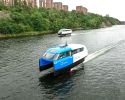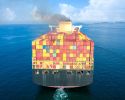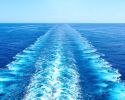Sprinkler systems work less well on the west coast

Salt increases the corrosion rate in steel pipes. This may be a reason why the nozzles in sprinkler systems become clogged more quickly on the west coast than on the east coast. This is mentioned in a pre-study carried out within the Swedish Transport Administration's industry program Sustainable Shipping, which Lighthouse runs. The study has produced suggestions on how sprinkler systems can be improved on rudder tires.
This week, there were reports of how the ro-ro ship Euroferry Olympia caught fire off the coast of Greece with almost 300 people on board, as well as cars and trucks in the hold. Most could be rescued, but at least eight people lost their lives and several were taken to hospital.
What caused the fire at Euroferry Olympia is unclear at the time of writing, but in recent years, poorly functioning fire extinguishing systems have been repeatedly pointed out as a reason for uncontrolled fires on ro-ro vessels. The ReliS - Reliable Sprinkler project, which was carried out within the Swedish Transport Administration's industry program Sustainable Shipping run by Lighthouse, has taken a closer look at how reliable sprinkler systems are in the cargo holds of Swedish ro-ro vessels and how they can be improved and made more reliable.
A common problem is that deposits or other unwanted particles in the pipe system clog the nozzles of the sprinkler systems.
“When tests are done on the ships, there is almost always a nozzle that is clogged. The nozzle is then taken down and cleaned, but it does not solve the basic problem which is mainly due to corrosion in the pipes. The next time the system runs, the same thing may happen again. This is not captured by the regulations because you get approved if you clean the nozzles”, says Anna Olofsson, fire engineer at RISE, who led the work with the pre-study ReliS - Reliable Sprinkler
Corrosion that occurs in the often several decades old steel pipe systems is what mainly causes the problem. And the corrosion rate increases if seawater, especially salt water, is used in the system. The vessels that were included in the study seemed to experience differences depending on which side of Sweden was served.
“We noted that crews on the east coast did not experience the same problems with internal rust and pipe flakes as they did on the west coast.”
During a series of workshops, suggestions for improvements were developed. They focused on two concept solutions that can be further developed.
“One is about the pipe material. What should we have in the system of the future? Some have gone from galvanized steel to stainless steel, but it is not certain that it is that much better in the long run. There was also talk of black steel, but we did not draw any conclusions about which material is best. Everyone has their pros and cons.”
The second concept is about avoiding seawater when testing. Many modern systems are already being tested with fresh water - for the elderly, a rebuild of the system is required that allows testing and flushing with fresh water.
“The next study could focus on the sprinkler system of the future. We envisage some form of long-term study where we, together with experts, look at the conditions of various materials regarding, for example, the risk of corrosion, resistance to high temperatures and installation and maintenance costs”, says Anna Olofsson.
-
 Ny studie: Eldrivna pendelbåtar kan effektivisera Stockholms kollektivtrafik
Ny studie: Eldrivna pendelbåtar kan effektivisera Stockholms kollektivtrafik -
 Sjöfartens utsläpp ökar
Sjöfartens utsläpp ökar -
 Sociala relationer påverkar val av bränsle
Sociala relationer påverkar val av bränsle -
 Sjöfartens omställning kräver ”mjukare” påtryckningar
Sjöfartens omställning kräver ”mjukare” påtryckningar -
 Hon hade avtalad tid med Kapten ynkrygg
Hon hade avtalad tid med Kapten ynkrygg -
 Lighthouse omvärldsanalys 2025 – osäkerhet och tullar präglar sjöfarten
Lighthouse omvärldsanalys 2025 – osäkerhet och tullar präglar sjöfarten -
 Se seminariet Shipping in the Marine Environment
Se seminariet Shipping in the Marine Environment -
 Vad betyder egentligen de 90 procenten?
Vad betyder egentligen de 90 procenten? -
 Hålla där...
Hålla där... -
 Ny rapport: Klimatförändringarna ett hot mot de flesta större hamnar i världen
Ny rapport: Klimatförändringarna ett hot mot de flesta större hamnar i världen

